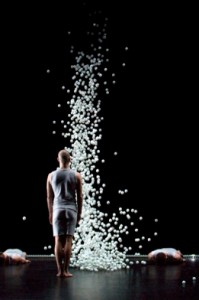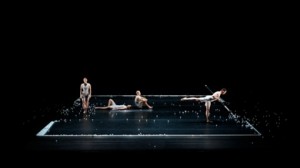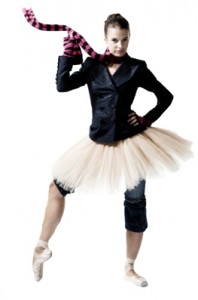(BECKET, Mass.) – Performer, choreographer, and media artist Jonah Bokaer will combine dance, architecture, and visual art in an innovative program of two U.S. premieres in the Doris Duke Theatre at Jacob’s Pillow on August 3-7. Bokaer and his dancers will perform the site-specific RECESS, designed by acclaimed visual artist Daniel Arsham, and Why Patterns, in which 10,000 Ping-Pong balls cascade from above, causing dramatically different configurations and reactions in every performance. Also at the Pillow through the weekend is 3e étage/3rd Floor, a contemporary ballet ensemble formed by and featuring dancers and soloists of the legendary Paris Opera Ballet, in the Ted Shawn Theatre.
Still not quite 30 years old, the Ithaca, N.Y. native, who joined the Merce Cunnngham Dance Company at age 18 while studying media and performance at the New School, Parsons School of Design, and NYU, was included in Dance Magazine’s “25 to Watch” feature in 2006. Last year, the New York Times included him in its “Nifty Fifty: America’s Up-and-Coming Talent” group, and this year Crain’s New York Business included him in its “40 Under Forty” feature. As a co-founder of CPR – Center for Performance Research, in Williamsburg, Brooklyn, he is also an advocate for green building, artists’ rights and arts support. Bokaer is also big in France.
In addition to Cunningham, Bokaer has worked with John Jasperse, David Gordon, Deborah Hay, Tino Sehgal, and Robert Wilson. Both of Bokaer’s works at the Pillow are collaborations: RECESS with Arsham and Why Patterns with architectural design firm Snarkitecture, established by Arsham and Alex Mustonen. Rather than design buildings, Snarkitecture investigates structure and materials within a space and how they might be manipulated in order to serve new and imaginative goals. The firm intentionally searches for established architecture sites with a possibility for confusion or misuse, aiming to reconfigure spaces to make them work against their intended purpose.
The U.S. premiere of RECESS explores Bokaer’s collaborations with Arsham and the origins behind their ongoing works. Made specifically for the Pillow, Arsham proposes a single white sheet of photographic set paper, which Bokaer transforms 30 times, often creating magical illusions from the simplest of materials. RECESS explores concepts of architecture, time, expansion, rational vs. natural form, and is staged site-specifically for the Doris Duke Theatre.
The recently revised U.S. premiere of Why Patterns is inspired by composer Morton Feldman’s1978 piece, also titled Why Patterns. Feldman stated, “There is not one organizational procedure more advantageous than another, perhaps because no one pattern ever takes precedence over the other.” Bokaer, in turn, comments “With these words in mind, I believe that thirty years later it still remains a radical, architectural, and poetic gesture to question the nature of compositional patterns – either imposed, designed, or random. In collaboration with Snarkitecture and the dancers, I have choreographed games that change every night, and cannot be predicted. As I watch the piece, I still wonder why these patterns emerge, and how.”
In the work, a single Ping-Pong ball initiates a compelling relationship of movement and ideas. Four dancers, dressed in newly designed costumes by former Marc Jacobs designer Richard Chai, perform surprising and spontaneous choreographic games that change in every performance. At one point, 10,000 balls drop from the ceiling, filling the stage and creating unpredictable patterns of their own. New for this premiere, commissioned music by electronic composer Alexis Georgopoulos is merged with Feldman’s original, tonal composition. Bokaer also recently received support from the National Endowment for the Arts for the reconstruction of Why Patterns, specifically for his Jacob’s Pillow engagement.
An alumnus of The School at Jacob’s Pillow, Bokaer trained in dance at Cornell University and North Carolina School of the Arts, and joined Merce Cunningham Dance Company at the age of 18, the youngest dancer to ever join the company. In addition to his work with Merce Cunningham, Bokaer has worked with acclaimed artists such as David Gordon, Deborah Hay, John Jasperse, Tino Sehgal, and many others. He is a frequent choreographer with avant-garde stage director and playwright Robert Wilson, best known for his collaboration with Philip Glass on Einstein on the Beach. Joan Acocella of the New Yorker states, “You can count on Jonah Bokaer to present something fascinating and unexpected in his smart, sophisticated collaborative projects.”
Classical virtuosity and wit are the hallmarks of 3e étage, a contemporary ballet ensemble formed by and featuring dancers and soloists of the legendary Paris Opera Ballet. The company was named for the third floor (3e étage) of the illustrious Palais Garnier theatre, where new dancers of the Paris Opera Ballet are first assigned dressing rooms. Directed by Paris Opera Ballet dancer and choreographer Samuel Murez, 3e étage performs contemporary repertoire, unleashing their technical abilities in a lively blend of irreverence and fun. They make their U.S. debut at Jacob’s Pillow Dance Festival August 3-7. The full-length program, titled Disorders, features ten contemporary ballet works, eight of them U.S. premieres, including Richard Siegal’s For Hands, the witty duet me2, and Processes of Intricacy, a duet choreographed by Murez.
Founded in 2004 by Murez, who joined Paris Opera Ballet in 2001, 3e étage has a distinctly French style. The company aims to bring playfulness and a rebellious nature to their performances by combining the rigorous training and classical technique for which the Paris Opera Ballet is renowned, with appealing contemporary works. Murez explains, “One of the central goals of 3e étage is to mix our experience and craft, our specialized knowledge and skills, into something that can be appreciated by first-time theater-goers as much as by dance connoisseurs.”



